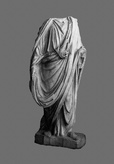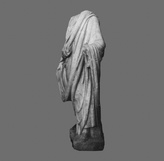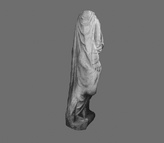- FundeFigs. IV. 46-50
Figs. IV. 46-50
Amman (Ras al- ‘Ain), Jordan Museum, inv.-no. J. 262.
From Gerasa / Jerash, found in the north hall of the eastern baths.
White, fine-grained marble with light to dark greyish layers.
Head broken at the base of the neck, left outstretched hand missing. Apart from smaller bruises at the ridges of the drapery, the torso is intact. At each of the two lateral sides of the plinth is a dowel hole (Dm 5.5 cm) filled with led to hold iron clamps. The entire surface is covered with a transparent ivory patina, which has a darker coloration at various points, especially on some ridges of the drapery.
H 179 cm; Pedestal 42 x 67 cm; H of pedestal 15.9 cm.
The formal composition of the movement motifs adjust to the frontal view. The man draped in toga and tunica stands on an almost rectangular thick plinth with beveled rear corners. The frontal face is slightly inward curved. Both feet standing firmly on the ground, the left one is directed to the corner of the pedestal. Both upper arms are lowered, the right hand grasping the seam of the sinus, the left arm angled in the elbow with the lower arm horizontally forwarded. Possibly the man held with this hand a book scroll (volumen, rotulus). A cubic block behind the lacinia and a spur of coarsely picked marble behind the right food give support to the statue.
Under the toga the man wears a long sleeved tunica. The fabric forms triangular flat folds under the neck cut, flat vertical stretched folds round over the breast. The voluminous textile of the sleeves hangs in a triangular fan-shaped drapery out of thin curved folds below the right lowered arm, which the horizontal balteus resumes. The sumptuous toga shrouds the contours of the body almost utterly. Only the moving right knee and the right buttock stand out under the garment as soft bulges. The oval sinus is broad and flat with projecting rounded seam, along the waist down to the thigh its fabric clings close to the body and form flat U-shaped staunching folds. The gathered balteus lines horizontally with deep shadowed drapery grooves, in it’s upper part an additional layer of the toga’s hem hangs on it as the drop-shaped umbo. Dense oblique drapery rips transverse the left thigh, the lower seam touches the ground and the lacinia is organized into stiff vertical textile bars. The calcei are laced by three leather straps around the ankles, an indication for the senatorial shoe.The back side of the statue is divided by the vertical compartment of the toga, but in all the workmanship is more summary.
Mid to the third quarter of the 2nd century AD, early to middle Antonine, probably an import from the city of Rome.
Bibl.: Fischer 1998, 264 note 385; Friedland 2001, 473; Gadara I, 490 no. C 11 pl. 129A–D;
Friedland 2003a.



